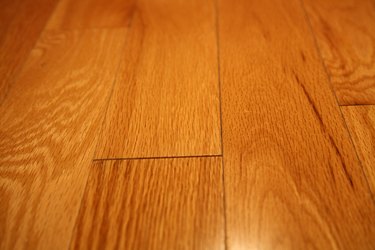Things You'll Need
Joiner
Table saw or router

T-molding is a device used in building floors. It has three common uses: joining wood floor boards in adjoining rooms, transitioning between a wood floor and another floor, and serving as an expansion joint on floors that measure more than 40 by 30 feet. T-molding helps to create a transition when you switch from wood to another flooring material like carpet because it creates a raised area that clearly separates the two types of flooring and defines the spaces as separate spaces. It also helps to minimize cupping between floor boards in larger rooms that can occur as wood expands and contracts due to humidity and temperature changes.
Step 1
Take measurements of the place you will be using the molding so you know how long of a T-molding to cut. This could mean measuring the opening of the door or entryway to another room or along the place where your floor is transitioning.
Video of the Day
Step 2
Use a jointer to flatten the edges before cutting your board or rip the edges on a table saw, making sure the rip fence is parallel with the blade. A jointer is a tool used in woodworking to smooth and flatten out rough edges of wood; it has an infeed and outfeed, a fence to keep wood in place and a cutter to smooth out the surface. Wood goes into the infeed between the fence and the cutter head and a motor makes the cutter head spin, causing the head's sharp knives to remove any raised areas or ridges and flattening its surface
Step 3
Choose your tools. One option is to use a table saw with a molding head cutter, a special attachment that allows the saw to make rounded precision cuts necessary for molding. Another option is to use a router, which is a special hand-held or power cutting tool that is shaped to allow you to make grooves when doing woodworking projects. Of the two, the router is considered the safer and cheaper option because the assortment of bits that allow you to take out smaller pieces of wood and gives you a greater variety of cuts to choose from.
Step 4
Make the cut. Pass the wood into the router on its edge or face, holding it against the fence. The height of the router bit affects cut shape as does the distance from the fence. The farther the distance, the longer and wider the T-molding will become.
Tip
If you are using a router to make T-moldings, think about purchasing one that operates at different speeds so you can alter the speed depending on how large the pieces of wood you’re cutting out are. Getting a router that will work with 1/2-inch diameter shank bits -- the cylindrical tools that are used in the router to make cuts -- is also a good idea because they can handle more heat and stress than 1/4 inch ones. You will also need a router table, preferably with an adjustable fence so that you can concentrate on putting the wood through instead of worrying about manipulating the router over the wood.
Video of the Day